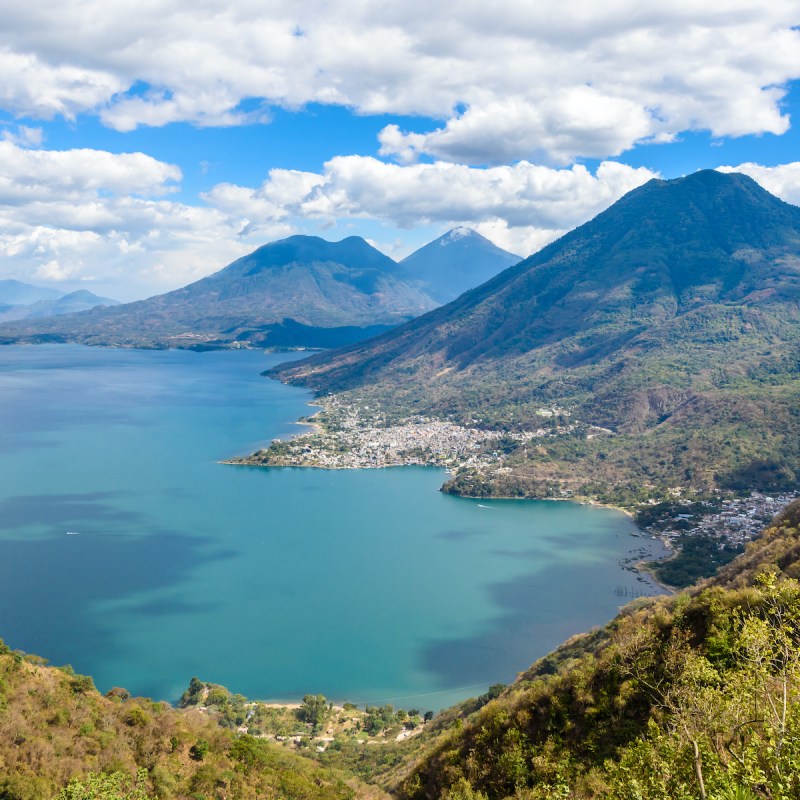
(Simon Dannhauer / Shutterstock.com)
Touted as one of the most beautiful lakes in the world, Lake Atitlan lives up to its fame. An indigo lake hidden by the Toliman, San Pedro, and Atitlan volcanos covered in emerald forests attracts people from all parts of the globe. Tranquility mixed with delicious comfort food, merriment, and Mayan artisan crafts are uncovered in this special patch of Guatemala.
Videos by TravelAwaits
Landing in Guatemala City and hiring a tour company to chauffeur my friends and me to the lake turned out to be the best path to take. The distance is not the issue, but finding the right roads in a country that does not consider signage important would have been a time thief.
A bonus to this 10-day journey was experiencing the lovely countryside with a guide who knew our personal interests and where to find the perfect places to stop. We saw the best of Guatemala as we aimed for our final destination — gorgeous Lake Atitlan.

(Photo Credit: Ann Bush)
1. Antigua
A short detour off the Pan-American Highway just a few hours from Guatemala City is Antigua, a bustling town that has survived for centuries at the foot of the active Volcan de Fuego. Abandoned after a devastating earthquake and rebuilt in the late 1700s after Spanish colonization, this UNESCO site has retained the distinctive Spanish Baroque style.
As a historic preservation buff, I could have spent hours roaming the beautifully restored village square and churches, but one of us discovered the jade factory. A gemstone used for centuries by the Mayans who believe jade has a spiritual significance connecting the Maya people to the natural world, Guatemalan jade is a pictogram of Guatemala’s natural beauty.

(Photo Credit: Ann Bush)
The Jades Imperio Maya jewelry store located around the corner from the central plaza is also a museum of ancient jade artifacts blended with modern jade carvings. In the back, visitors watch skilled artisans carefully carve gems of several green shades into stunning jewelry.
Pro Tip: Factory tours are free; however, space is limited. Arrive early and be patient as only a few people at a time can comfortably watch the artists.

(Photo Credit: Ann Bush)
2. Los Tarrales Natural Reserve Patutul
Following the southern route keeping the Volcan Atitlan between us and Lake Atitlan, our next stop was the Los Tarrales Natural Reserve. Operating as a coffee farm since the early 1800s, the area includes a large bamboo forest, waterfalls, and a diverse ecosystem that attracts over 300 species of birds.
About 20 years ago, the owners realized the importance of conservation to save the birds. Now a 2,800-acre private reserve with a lodge, cabins, restaurant, and guided tours, Los Tarrales attracts visitors who come to Guatemala for their distinctive birds.
Bird watching was a common interest among us and waking up to quacking white-bellied chachalacas outside cabin windows was a treat. Watching orioles and woodpeckers devouring bananas from the outdoor coffee bar was the perfect start to an amazing day. It ended with us running past a coffee field to get a better look at a spectacular white eagle flying above our heads.
Pro Tip: Visits to Los Tarrales must be reserved 24 hours in advance, especially lodging and guided tours. Absolutely do not miss the gift store.

(Photo Credit: Ann Bush)
3. Los Andes Nature Reserve & Finca
At 4 o’clock in the morning, darkness enveloped beams from phone flashlights used to safely climb a few steps onto a large flatbed trailer. Used during the day by coffee pickers, there was no place to sit, so we held on tight as a tractor pulled us slowly up the mountain. New to tourists, this multigenerational family-owned tea and coffee farm was without fancy equipment, but that didn’t deter us from going to a place worth a bumpy ride.
When the tractor finally stopped, we quickly gathered in the morning dew sitting on sawed tree stumps silently devouring coffee and a packed breakfast to watch the show — an amazing sun rising against the smoking Volcan Atitlan. Later we toured tea fields, hiked trails bursting with amazing birds, and finally rested our bones in a lovely garden with hummingbirds zooming over our heads.
Pro Tip: When the tractor driver says duck, drop down because it means a tree limb is hanging over the road. As bird watchers, we instead looked up and learned our lesson the hard way!

(Photo Credit: Ann Bush)
4. Lake Atitlan Itself
In the heart of the Sierra Madre Mountains, the lake is 130 square kilometers (50 square miles) and extremely deep, contributing to the lake’s intense ocean blue hue. An expat paradise, large homes crawling up the volcano with private access to the lake are barely visible. Throughout the hills and valleys are family farms with fields of corn, orchards, tea, and coffee sharing space with a lush forest along the sides of volcanos.
Seven Mayan towns surround the lake, all within a boat ride away. There are numerous ports crammed with boats of all sizes ready to take passengers. Most village residents use boats — often handcrafted — to cross the lake, which is a much shorter trip than driving around the lake. For a large, modern boat, the price was 25 quetzals each, roughly $3. The reasoning for such low cost is that local people constantly need to use boat transportation for employment and cannot afford to pay a large fare.
We used a boat to transfer from town to town every day and never tired of the scenic ride. Here are a few of my favorite places on the shores of Lake Atitlan.

(Photo Credit: Ann Bush)
5. Santiago
Considered the lake’s crown jewel, Santiago has a high population of the Tz’utujil people, skilled farmers and artisans of goods sold in a bustling market. Located at the end of a bay between two volcanos that calm the lake, Santiago has a dreamlike atmosphere attracting yoga enthusiasts and is the best place to rent kayaks because of the smooth water. The following (entries 6 and 7) are some of the best things to experience in town.

(Photo Credit: Ann Bush)
6. Cojolya Weaving Center And Museum
The best of Guatemala is often found at places built and operated with indigenous pride such as the Cojolya Weaving Center. Created during the Guatemalan Civil War, the organization’s purpose was to help widows earn money and support their families. The Cojolya Association was formed 10 years later to broaden the market globally, further empowering Tz’utujil artisans and preserving the remarkable ancient skills of backstrap loom weaving.
Now a World Fair Trade Organization, all artisans and staff are Tz’utujil women with access to jobs with pride in their skills handed down many generations. Our guide went further than simply scheduling a shopping stop, adding a lesson on weaving — from picking the cotton through the spinning, dyeing, and weaving process. The center is crammed with beautiful products where we happily shopped for gifts. However, meeting the artisans was an impeccable gift to us from people who dearly love their homeland.
Pro Tip: Find other ways to support these beautiful women by reviewing their new website at www.cojolya.org.gt.

(Photo Credit: Ann Bush)
7. Hotel Bambu Garden
Our hotel for the next 5 days was beautiful, designed to blend seamlessly with the natural environment. Made of bamboo, carved stone, and thatched roofs, the hotel further respects the ecological environment of the region by banning plastic and opting to use cloth trash can liners and glass water bottles instead.
Between tours, meals, and naps, their Ecobambu Garden was my favorite place where flowers, birds, butterflies, and dragonflies of all colors and dimensions flourished. To my delight, five different oriole species graced the garden flashing their signature black and orange feathered attire.
Pro Tip: The hotel’s loveliness is enhanced by a breath-taking view of Lake Atitlan from the restaurant, which included a delicious variety of vegan dishes on its menu.

(Photo Credit: Ann Bush)
8. Panajachel
Gateway to Lake Atitlan, Panajachel is the largest and busiest town on the lake. The village is a wonderful example of different cultures living in harmony among volcano shadows. Hiking at the Reserva Natural Atitlan winding up a volcano one morning resulted in unprecedented lake views.
Shopping was our interest on the last day of our trip. The town’s main street, Calle Santander, is famous for a market where inexpensive handmade trinkets for grandkids to professional first-class Guatemalan art can be found. My favorite place was the Expresiones Galeria de Arte, where artist Salvador Reanda himself was eager to tell the story behind his paintings.
An inspirational place for Mayan history enthusiasts was our hotel, the Posada de Don Rodrigo. The Museo Lacustre Atitlan or “Lakeside Museum” showcased ancient Mayan artifacts recovered from the bottom of Lake Atitlan. Historians speculate that these rare items were memorials for respected Mayans that once lived in the flooded ancient city of Samabaj.
A pleasant surprise at this historic hotel was Santa Claus roaming the patios zigzagging between multi-colored striped hammocks. It was December, and Guatemalans love to celebrate Christmas.
Pro Tip: Lunch in the market at courtyard cafes serving stuffed Guatemalan tortillas and Licuados, a regional fresh fruit drink. Canvas art abounds and many will offer to ship paintings, however, ask hotel staff first if the store is trustworthy.
For more ideas and inspiration on Central and South America, explore these articles:
